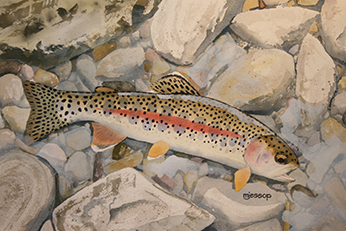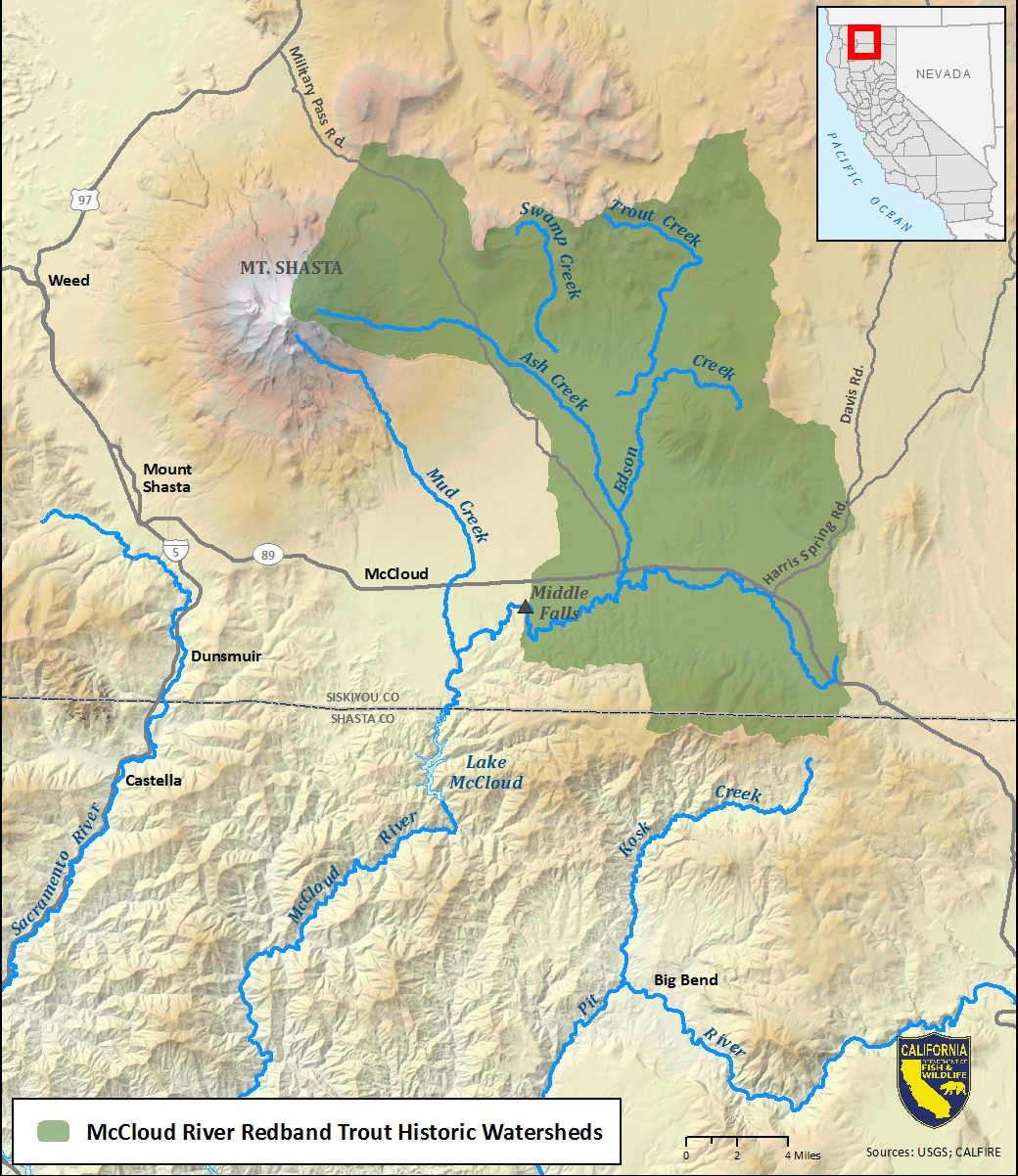Oncorhynchus mykiss calisulat
Distribution and Habitat
 © Mark Jessop, all rights reserved.
© Mark Jessop, all rights reserved.
 Map of McCloud River redband trout historic watersheds. (click/tap to enlarge)
Map of McCloud River redband trout historic watersheds. (click/tap to enlarge)
McCloud River redband trout are native to the upper McCloud River (Shasta and Siskiyou counties), a tributary to the Sacramento River. It is believed that redband trout were historically the only native fish species found in the McCloud River and tributaries above Middle Falls.
Non-native trout, including rainbow, brown, and brook trout, were introduced into the upper McCloud River as early as the late 1800s. McCloud River redband trout can interbreed with coastal rainbow trout, creating hybridized offspring that may not be as well adapted to the arid environment in which redbands evolved. These offspring and subsequent generations tend to exhibit a progression away from redband-like physical traits toward rainbow ones. Brown and brook trout compete for limited habitat and larger brown trout that become piscivorous (fish eating) may prey on juvenile trout.
Today, pure McCloud River redband trout are found mostly in isolated headwater tributaries where non-native trout were not introduced. The majority of these headwater tributaries flow off the southern slopes of Mount Shasta and feed the main-stem McCloud River from the north.
Threats
Due to the introduction of non-native trout, McCloud River redband trout are currently confined to small isolated, headwater streams. Land use activities including logging, grazing, water use, and roads further impact this species.
Conservation and Management
Conservation measures have been taken to protect the remaining populations of McCloud River redband trout for over 40 years. Since 1994, hatchery rainbow trout are no longer stocked in the upper McCloud River to limit further hybridization and competition. Pure populations identified from genetic analysis were relocated to other streams to create additional refuge populations in the event of environmental catastrophes such as wildfire, drought, or disease. Some streams in the upper McCloud River basin are closed to fishing to further protect them and land use practices have been substantially improved.
In 1994, the McCloud River redband trout was identified as a candidate species for listing under the Federal Endangered Species Act. To preclude listing and reduce the threat of extinction, state and federal agencies collaborated with local landowners and formed the Redband Core Group. A conservation agreement was created in 1998 to identify threats and help protect these trout and their habitats. Numerous restoration actions have occurred under this agreement and McCloud River redband trout were not listed as Threatened or Endangered. Examples of restoration activities include improving roads to reduce sediment inputs, fencing streams from livestock, and protecting key streams from logging, fire, angling, and off-road vehicles.
CDFW recently accomplished a status assessment of the pure populations and information generated from these surveys was used to revise and update the conservation agreement.
CDFW and the U.S. Forest Service actively monitor redband populations and habitats and conduct restoration activities as partners in the Redband Core Group. CDFW is working with the University of California, Davis to conduct a genetic analysis of fish in all upper McCloud River tributaries to determine the proportion of “pure” versus hybridized fish and to hopefully identify additional core populations. Drought has severely impacted available habitat in all streams supporting core conservation populations and this subspecies is now at high risk. Negative genetic impacts (bottlenecking, inbreeding depression, and drift) from very low population sizes are a principal threat, along with reductions in suitable habitat. To mitigate against low water, increased water temperatures in the summer, and freezing conditions in the winter, a large number of McCloud River redband trout were moved to the Mount Shasta Hatchery to protect this subspecies. In 2016, when conditions improved, some were restocked to their natal streams.
Species Status
McCloud River redband trout is a Species of Special Concern in California and a US Forest Service Sensitive Species.